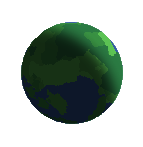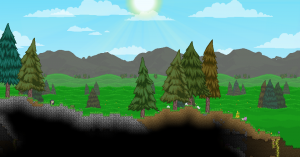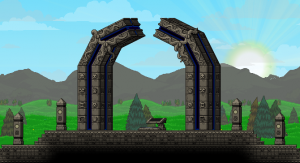Garden
| Threat: Low (Tier 1) | Weather | |
| Star types: Gentle | ||
| EPP Required: None | ||
| Mini Biomes: None | ||
| Secondary Biomes: Forest | ||
Lush biomes can be created and expanded using a Lush Terraformer, and a planet will convert to a Garden planet once half of the planet's surface has been terraformed into Garden biome.
Lush planets can only be found orbiting gentle (white) star types. There are no environmental hazards in garden biomes which require use of an environmental protection pack.
Lush replace a similar biome, Grasslands, that used to exist in beta versions of Starbound.
Gleap, Poptops, and Nutmidges have a chance of being found in garden biomes.
Garden biome planets can be identified by the keyword Lush in their navigation console description.
- Lush foothills mark this landing location. Both flora and fauna are abundant here. A beam site of immeasurable safety.
- The beam site is located in a tranquil area of great bio-diversity. There are resources here that you could use. A lush and pleasant land.
- Readings indicate the landing site is not unfavourable - the area is safe, and lavish with both flora and fauna. A lush and hospitable place.
Materials
The surface layer of gardens is primarily made up of dirt, cobblestone, and mud. There's an abundance of gatherable wood because of the plentiful trees. The planet's primary color in the navigation console and while orbiting above is the primary color of the dirt found there.
Most common early game ores are found in garden biomes, with of copper, silver ore, gold and iron available near the surface.
The surface of the ground is mostly covered in grass, and the topography is often hilly with small subterranean caves. On the surface and inside caves there are frequently small pools of water.
| Primary material | Sub material | Geological materials | |
|---|---|---|---|
Music Tracks
Garden biomes use the Day Tracks during the day and the Night Tracks during the night.
|
|
Sub Biomes
The only sub biome which can be found on garden planets is forest. When forest appear they'll include things like their associated blocks, trees, and crops.
Gardens can also be found on a number of different planet types as sub biomes. They have a chance of being found as sub biomes on forest, desert, savannah, snow, jungle, mutated, midnight, or decayed planets.
Mini Biomes
Garden biomes have no minor biomes. However, Garden planets can have forest mini biomes like spring or mushroom patch inside forest sub biomes.
Layers
Garden planets have a much more consistent layer composition compared to other non-Barren planets.
- Space: Asteroids
- Atmosphere: Atmosphere
- Surface: Garden (Primary Biome); Forest (Secondary Biome)
- Subsurface: Underground 0a or Underground 0b
- Shallow Underground: Underground 0a or Underground 0b; Wilderness, Mushrooms, Mini Village, or Tarpit
- Mid Underground: Underground 0c; Ice Caves, Stone Caves, Luminous Caves or Bone Caves
- Deep Underground: Underground 0d (note: this layer always has mud); Cell Caves, Flesh Caves or Slime Caves
- Core: Garden Core Layer
Weather
Weather in garden biomes is mostly clear, with occasional light rain and rare rain storms. Weather happens for each planet based on the weights given to the weather types (probability is calculated by dividing a single weight by the sum of all weights); the probability for weather types on garden planets is as follows:
| 0.85 | (85%) | |
| 0.0625 | (6.25%) | |
| 0.05 | (5%) | |
| 0.025 | (2.5%) | |
| 0.0125 | (1.25%) |
Wild Crops
There are a variety of harvestable crops found in each biome. These can be harvested by interacting with them or by digging them up. They'll drop produce and have a chance to drop a seed which can be replanted.
Wildlife
Garden biomes use 2 kinds of night terrors, 1 kind of small passive biped or quadruped, and 1 kind of small passive flying creature.
In addition to procedurally generated creatures, there are a variety of unique monsters, bugs and critters found in garden biomes. Some of these are also found in other biomes, while others are unique only to garden biomes. While these unique creatures have a chance to appear on garden planets, they will not all appear on each one. In addition to unique creatures, each biome has multiple types of both procedural ground and flying creatures.
Unique monsters each have combat attacks, and they must first be weakened before capture. Once weakened players can attempt to capture using a capture pod. If successful they can then be released to battle alongside and follow the player.
Critters are smaller non-combat unique creatures which are not capturable using capture pods. They can be captured without weakening them first by using a relocator gun. After releasing a critter from the relocator it will stay in the area it was released into.
Bugs are very small unique creatures which can be captured using a bug net, and are then stored inside placeable jars. Bugs which are captured using a relocator will fly after release instead of being kept inside a jar.
Unique Drops
Garden biomes have no exclusive costume sets, but there are a selection of cosmetic hats which can be found in Pod Chests. Commonly chests will contain plant fibre, timber, salves or bandages.
| Costume Armor |
|---|
Settlements
Garden biome planets always have two settlements on them. A camp, where there's an entrance to a mine dungeon as well as an ancient gate which leads players directly to the outpost after it's been initially repaired using core fragments.
Ancient Gate
Each garden planet has an ancient gate which players can use to travel to the outpost when they first encounter it. In order to use it initially they'll be tasked with gathering 20 core fragments.
Villages
No villages appear in Garden biomes.
Dungeons
Mines are the only dungeon type which appears on Garden planets.
Screenshots
| Biomes | ||||||||||
|---|---|---|---|---|---|---|---|---|---|---|
| ||||||||||







